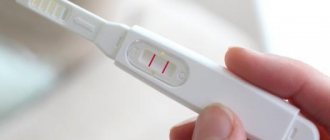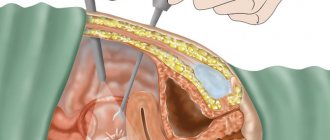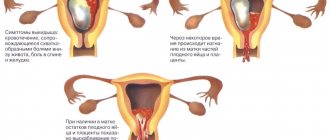Bathing
To bathe a newborn, you should stock up on a small plastic bath, a thermometer, special baby soap without additives or bathing foam, and a baby washcloth. It is better to use a small piece of gauze, which after the procedures can be washed, boiled and ironed. Provide a separate diaper for bathing. You should stock up and you can buy it, but you can use any vegetable, after boiling it and adding a couple of drops of vitamin A.
You can start bathing your baby completely when the wound on the navel dries out. This hygiene for newborn girls is carried out every evening before going to bed. The baby needs to be fed an hour and a half before the procedure, otherwise she may regurgitate the milk.
Bathing water should not be higher than 37 degrees; check the temperature with a thermometer. Place a diaper on the bottom of the bath. Fill up with water and slowly lower the baby into it. Wrap the edges of the diaper around the girl and begin to gently pour water over her. When the baby begins to get used to the water, you can remove the diaper. Wash the baby's entire body thoroughly with water.
You should bathe your child with soap no more than once a week. No matter how gentle its composition, it will still dry out the baby’s delicate skin and disrupt its protective layer. A newborn baby does not come into contact with the environment and the skin does not get heavily soiled, so a simple wash with water is quite enough. If desired, you can add natural herbal decoctions to the water, but first make sure that they will not dry out the skin.
After bathing, the baby's skin should be thoroughly blotted from moisture with a clean diaper. If necessary, treat skin folds with oil.
Water treatments
To bathe your baby, you should stock up on a suitable plastic bath, a water thermometer, baby soap and a soft towel or diaper. It is better if you have gauze on hand that can be boiled, washed and ironed. Baby powder or starch, sterilized oil will not hurt. Of course, it is recommended to boil any oil in advance and add 2-3 drops of vitamin A. You can purchase ready-made oil with the aroma you like at the pharmacy.
It is recommended to begin full water procedures when the umbilical wound dries out. Let bathing become a daily ritual, after which the baby will fall asleep peacefully. An hour and a half before the procedures, the baby must be fed, otherwise during bathing there is a risk of regurgitation of milk. In addition, a well-fed child behaves calmer and more relaxed.
It is recommended to bathe your baby with soap no more than once a week, since the composition of the cosmetic dries out the baby’s delicate skin, damaging the protective layer. Since the newborn is not yet in contact with the outside world, her body is protected from severe pollution. Therefore, a simple ablution with warm water is enough. To calm the baby and improve sleep, it is recommended to add herbal decoctions to the water, but the concentration should not be strong. After water procedures, the baby should be thoroughly but carefully blotted with a clean diaper or towel. It is important to treat skin folds with oil or baby cream.
Washing
Babies can relieve themselves up to 20 times a day, so the hygiene of a newborn girl must be observed very carefully. At such a tender age, the skin and mucous membranes are very vulnerable, and the slightest excessive exposure to moisture and feces can cause irritation, redness, rash and infection.
After each small hike, you need to thoroughly dry your skin, and after bowel movement, wash it with warm water. You should wash your child only after the bulk of the dirt has been removed with a napkin. All babies are washed strictly from front to back, to avoid contamination of the genitals. Afterwards you need to blot the moisture with a napkin. You should not rub your delicate skin with a towel; such manipulations will quickly lead to irritation. If irritation occurs, apply sterile oil or powder to them.
How to wash properly?
In the first days and weeks after birth, babies defecate up to 20 times a day. Therefore, hygiene and care rules should be observed very carefully and regularly. Since at such a tender age the skin and mucous membranes are very vulnerable and sensitive, the slightest exposure to foreign microorganisms or even water causes irritation, redness, swelling, rash and even infection.
Every time a girl walks “in a small way,” it is important to thoroughly dry the skin, and after defecation, wash it with warm water and soap. But it should be brought under running water when the bulk of the feces has been removed with a napkin. The unspoken rule for washing expectant mothers is strictly from front to back. This will eliminate the possibility of impurities getting into the genitals. It is not recommended to rub delicate skin with a towel or diaper, as this will result in irritation and, in difficult situations, cracks and bleeding. Moisture is blotted with a napkin,
Girl's secrets
Hygiene of newborn girls also includes constant monitoring of the condition of the genital organs. The baby's tiny body has a huge number of glands, and the secretion they secrete can be an excellent platform for the development of pathogenic microflora.
Intimate hygiene of a newborn girl comes down to constant inspection and cleansing of the genital area if necessary. If you find that the labia are stuck together with secretions, you need to carefully move them apart with a damp cotton swab, remove the secretions and then dry them with a napkin. Failure to keep this area clean can lead not only to inflammatory processes, but also lead to the formation of adhesions of the labia.
Intimate hygiene of newborn girls comes down to caring for the external genitalia. The internal organs are very delicate and vulnerable, so you need to make sure that water does not get there at the time of washing. This can cause an inflammatory process. Girls should be washed by placing them on their backs, and try to avoid washing in basins or bathtubs at first.
If you find that your baby has inflammation, strange discharge and a fever, you should immediately seek help from a specialist.
Hygiene rules
Courses for young parents always include a topic that focuses on caring for newborns. Since in the first days of life the baby’s body is defenseless, you need to follow important recommendations.
When washing a child, you should use only boiled water, with a temperature of about 36 degrees. Some doctors recommend adding a weak chamomile decoction. However, you need to remember that this herb can dry out the mucous membrane and often causes a fairly serious allergic reaction. It is better to give preference to natural and proven cosmetics that were created specifically for newborns. After a few weeks, boiled water can be replaced with running water. But in this case, it is necessary to think through the filtration system. Everyone knows that the pipeline contains a huge number of microbes. Girls' hygiene must be correct. First of all, you need to rinse the perineum and only then move on to the anus. Otherwise, you may accidentally introduce particles of the baby’s feces into the vagina. Such pathogenic organisms can provoke a serious inflammatory process or even infection
Therefore, it is important to wash in the correct sequence. Do not rub the baby's skin or mucous membranes too much
You need to monitor the condition of your hands. You need to give up manicures and long, especially extended nails. They can easily damage thin coverings. In addition, it is much more difficult to remove dirt under long nails. To avoid fusion of the labia in a child, you need to periodically carefully move them apart. When using powders, it is important to ensure that the product does not get into the perineum.
- In the warm season, after washing, you can give your child air baths. To do this, it is enough to give the baby the opportunity to be without a diaper for some time.
- During washing, you need to hold your newborn girl correctly. The child is placed with his back down on the hand of the parent who performs the procedure. Thus, you need to hold the girl with one hand, pressing her a little closer to you, and wash with the other. You need to make sure that the child is comfortable and cannot slip onto the floor.
- The child must have his own towel, which no one else in the household uses. It should also be washed with the baby’s clothes, and not with the common dirty laundry of other family members.
- Do not overuse all kinds of wet cleaning wipes. They are convenient to use, but often lead to an allergic reaction. Such products can only be used if there is no access to clean water. This means that such napkins can only be used as a travel option.
Girls' hygiene is extremely important. When unpleasant discharge appears, it is worth assessing its color and characteristics. If you notice a very unpleasant odor, you should consult a doctor.
What is a “sexual crisis”
At the time of the onset of a “sexual crisis,” the hygiene of girls should be especially careful. Newborn babies at 4-7 days from birth begin to be bothered by swelling from the vagina. This does not happen to everyone, but such manifestations should not frighten the mother, they are considered normal and last from one to several days. At such moments, you should wash the girl with a weak solution of potassium permanganate or ordinary boiled water.
Such unusual manifestations occur due to the fact that maternal hormones enter the newborn’s blood. The situation is stabilized by the body on its own, without any outside help.
Discharge from the genital tract in a 12 year old girl
Puberty takes from 8 to 15 years.
Inflammation of the vulva and vagina is rare. The course of the infection is mild. Girls have no complaints other than bad-smelling leucorrhoea. This indicates the beginning of hormonal changes in girls’ bodies and the maturation of the immune system.
But during this period, thrush is more common. From the beginning of puberty, leucorrhoea may appear due to inflammation of the uterus, fallopian tubes and ovaries.
Discharge in teenage girls can be caused by vegetative-vascular dystonia. They develop due to sudden hormonal fluctuations. In addition to leucorrhoea, girls usually complain of increased fatigue, irritability, poor appetite and sleep.
The appearance of white discharge in girls indicates the beginning of puberty. Such leucorrhoea is not profuse, may have a yellow tint, and is odorless.
Brown discharge in girls
They have this color due to the admixture of blood. They talk about the imminent start of menstruation.
But here the mother should be extremely careful, because brown discharge can occur with inflammatory diseases, injuries to the genital organs, or a foreign body in the vagina.
You should pay attention to the time of appearance and duration of coffee discharge. If they precede menstrual flow or continue for several days after, this is a normal option
If their appearance does not depend on the phase of the cycle, the child should be shown to a specialist.
Green discharge in girls
Yellow-green discharge in a girl indicates an inflammatory process of the vulvar and vaginal mucosa. The green color of the leucorrhoea indicates the presence in the secretions of leukocytes in large numbers, as well as microbes and their metabolic products. There is purulent inflammation in the vagina. Such discharge is typical for gonorrhea, thrush, trichomoniasis, bacterial vaginosis and other bacterial infections.
Are your breasts filling up?
It is not uncommon for the mammary glands to swell at the same time. This phenomenon is observed in babies for several weeks and goes away on its own. Enlarged breasts may produce a secretion called colostrum. If no additional inflammatory processes are observed, then the hygiene of a newborn girl comes down to general measures. Under no circumstances should you massage your breasts or squeeze out secretions from them. If your breasts are painful, there is redness or other signs of a possible disease, it is better to visit a doctor.
What kind of discharge in girls is considered normal?
Light discharge that has a uniform consistency and resembles mucus is considered normal.
A variant of the norm is the presence in the discharge of viscous “threads” or lumps similar to crumbs. Such leucorrhoea is normal in a newborn girl; it is a fairly common occurrence in the first weeks of a child’s life. After one month of age, there usually begins a period of rest when hormones do not manifest themselves in any way, and at 7–8 years, hormonal changes may begin. Puberty begins, heavy discharge and changes in the shape of the mammary glands may appear. After 2–3 years, menstruation occurs.
Cleaning ears and nose
Most people think that it is dirt that needs to be gotten rid of immediately. But it is not so. It plays an important protective function, so you should clean your ears without fanaticism. It is only necessary to remove the excess wax that is visible in the auricle. The ears of newborns are very vulnerable, so we will put off cotton swabs until better times; the child can jerk his head sharply and cause himself pain. We will use cotton rolls rolled into a tube. We slightly moisten the roller in warm water and carefully screw it into the ear canals, clearing them of wax. This procedure is also necessary after every bath, because water can get into the ear.
If mucus has accumulated in the baby's nose, it should be removed with an aspirator. Then lightly moisten a cotton swab in oil and carefully screw it into the nostril. Rotate the roller several times to remove any crusts. If the baby breathes freely through her nose and there are no crusts in it, then there is no need to clean it again. Use a clean cotton swab for each ear and each nostril. You can see how such hygiene is carried out for newborn girls. The photo is in the article.
She is an expectant mother
Compliance with hygiene procedures for infants is extremely important; they will help to avoid many unpleasant and dangerous diseases. We have covered the basic rules of how the hygiene of a newborn girl should be carried out in the first six months of life. Komarovsky O.K., Candidate of Medical Sciences and pediatrician, gives many recommendations for caring for the body of girls from the moment of birth until entering adulthood. You can follow his valuable advice in further raising your baby.
Hygiene for newborns is very important - after all, the skin of babies is very delicate, and it is necessary to care for it carefully, but carefully. This is especially true for intimate hygiene - after all, the genitals are very sensitive and require special care. The natural protection of the genital organs, “donated” by the mother at birth, is eliminated from the newborn’s body quite quickly - about a month after birth. And the child’s own defenses are activated much later. In this regard, intimate hygiene of newborns becomes especially important as a prevention of inflammation and infectious diseases of the genital organs of infants.
What means should be used to ensure intimate hygiene of newborns?
Intimate hygiene products for newborns
The most important products for intimate hygiene of newborns are gel or soap for washing with extracts of string, calendula or chamomile. Such products should not contain fragrances or dyes and should not dry out the skin. Gels and soaps for washing newborns gently cleanse the skin of the genital organs of babies and strengthen the body's protective functions. You can also use weak infusions of chamomile or sage. But the best way to cleanse the genitals of babies remains ordinary boiled or running water!
In order for this to be carried out according to all the rules, it is necessary that the baby has his own soft towel for intimate hygiene made from natural fabrics.
There must be cotton swabs next to the towel to wipe all the folds in the baby’s genital area.
If you are going on a trip, do not forget to purchase special alcohol-free baby wipes for caring for the genitals of newborns
.
Well, the end of the procedure for caring for the genitals of a newborn should be marked by wiping the skin with baby oil or cream.
The most important condition for choosing products should be their hypoallergenicity. And the most important rule is that with any cosmetics (including children’s) it is better to be a little “greedy” than to overdo it.
Intimate hygiene of newborn girls
The main procedure for caring for a girl’s genitals is washing. It should be done every morning and evening, as well as after every diaper change. Before you start washing, the girl must be placed on the changing table, the diaper removed and all remaining urine or feces removed with a clean paper napkin.
Now you can start washing. Remember that washing must be done carefully so that particles of feces do not get into the girl’s vagina. In this regard, any manipulations to wash the girl in the genital area should be carried out in the direction from the pubis to the tailbone.
Soak a damp swab in boiled water and wipe the girl’s belly from the navel down. After this, wipe the outer folds of the skin between the girl’s legs with another moistened cotton swab - from the stomach down.
Now take the newborn’s legs by the ankles and lift them, then wipe the girl’s perineum from the pubis to the anus with a cotton swab soaked in boiled water. If you can’t do it in one motion, change the cotton swab and continue.
Remember that intimate hygiene should not be accompanied by wiping the space between the labia minora and majora and the girl’s genital slit. Typically, a white coating appears between the labia, which provides protection to the girl’s genitals. This plaque should not be washed off under any circumstances - you can only wipe the excess on top of the newborn’s labia with gentle movements using a cotton swab dipped in oil. Never wash off the white deposits with soap or water.
At the end of the hygiene procedures, wipe the newborn’s thighs and buttocks in the direction of the anus with a cotton swab soaked in boiled water. At the very end, wipe the outside of the girl’s anus with a clean, damp swab.
Washing should also be done during bathing - under a gentle stream of running water. But under no circumstances place the girl in the bath while performing intimate hygiene for a newborn.
– water for washing should always be clean.
Direct the stream of water onto the baby's tummy so as not to cause any discomfort. Use your hand to make gentle movements from the navel to the tailbone, performing hygiene only on the external areas of the girl’s genitals. At the end of the procedure, gently dry the baby’s skin with a soft towel and treat it with cream or oil for intimate hygiene of newborns.
. After 10-15 minutes of air baths, you can put on a diaper. It is advisable to change diapers (and, accordingly, wash) newborn girls every 2-2.5 hours.
As for the frequency of washing, the rules for boys are no different from the rules for newborn girls. But, in general, intimate hygiene of newborns
boys must be carried out in their own way.
The rules of intimate hygiene that a boy will adhere to throughout his life are laid down in infancy. Therefore, it is very important to lay the right foundation for the future health of the baby.
When washing a newborn boy, remember that it is better to make all movements from front to back - to avoid infection in the genitals. It is better to use baby cosmetics very little at a time - running water is still the best means for washing. If the skin of the newborn's genitals is very sensitive, wipe it with wet water- or oil-based baby wipes.
A special secretion accumulates on the foreskin of newborn boys, an excess of which can cause bacterial growth and inflammation. Excess of this mucus must be removed when performing intimate hygiene for the newborn.
. It is enough to clean the head of the boy’s penis once a day – during bathing. To do this, slightly (without injuring the baby’s skin) push back the foreskin and wipe the head of the boy’s penis with a cotton swab dipped in boiled water or chamomile decoction. When the newborn grows a little, this procedure can be done using ordinary running water. In newborn boys, the foreskin is usually narrowed - but not to such an extent that it cannot be raised at all. Otherwise, the doctor decides this issue.
If redness appears on the head of the boy’s penis or on the foreskin, gently wipe these areas with a weak solution of potassium permanganate.
After these manipulations, treat the baby's skin with oil or cream for newborns and put on a diaper after 10-15 minutes of air baths.
We wish you that compliance with the rules of intimate hygiene for newborns becomes the basis for good health and good mood for your child!
Have you become a happy mother? Have you had a daughter? Congratulations! But remember that with her birth, not only boundless happiness, but also great responsibility settled in your home. After all, a girl is a future woman, and therefore a future mother. And you need to take her health very seriously.
And as you know, cleanliness is the key to health. That is why today we will talk about the hygiene of a newborn girl. Caring for a girl is very different from caring for a boy, so parents should familiarize themselves with the basic rules. This will prevent serious mistakes and make caring for your baby easier.
Causes of pathological discharge in girls
The moment of occurrence of painful discharge does not depend on the age of the child, but only on external factors that provoke its production. Factors may be the following:
- Decreased immunity. In situations that contribute to a decrease in the body's defenses (hypothermia, stress, poor lifestyle), harmful bacteria and other microorganisms present in the genitals are no longer restrained by the immune system. A signal of the growth of pathogenic microflora of the vagina is the excessive formation of vaginal discharge, the color of which depends on the multiplying infectious agent. For example, when infected with staphylococcus, a yellow-white thick secretion is released.
- Antibiotic therapy. As you know, these medications can kill not only harmful microorganisms, but also disrupt the natural microflora of the vagina, reducing the content of beneficial lactobacilli. This provokes the development of thrush and other fungal diseases that provoke white curdled discharge. The course of the infection is accompanied by severe itching and redness of the skin; the disease can easily develop in both infants and adolescents. Candidiasis is characterized by the presence of thick, odorless discharge.
- Sexual infections. Infection with such diseases most often occurs during childbirth, with transmission from mother to child. There are also known cases of the spread of sexually transmitted infections through household means, most often this is infection with Trichomonas, chlamydia, ureaplasma, and herpes virus. Against the background of such diseases, the girl experiences a strong burning sensation when urinating.
- Development of allergies.
The diagnosis of atopic vulvovaginitis is extremely difficult to make; only during a period of exacerbation of allergies can a doctor notice the true cause of the disease in a girl by analyzing the characteristic symptoms: swelling, vaginal hyperemia, pain, burning and itching, impaired urine output, excessive leucorrhoea. The discharge may have a red tint due to injury to the vulvar mucosa caused by deep penetration of the infection. When the first signs of the disease appear, you should immediately contact your pediatrician - The course of diabetes mellitus. A side effect of this disease is the spread of a fungal infection in the child's vagina.
- Entry of a foreign body into the vagina. Young children show interest in their body, and therefore they can bring a small object inside, which provokes the development of a strong inflammatory process. Often these are small toys, buttons, balls, batteries or threads. The true cause of inflammation can be suspected by a strong unpleasant odor from the vagina, as well as the appearance of yellow and green purulent discharge, sometimes with the presence of blood (then it turns brown).
- Worms. This problem can arise if the girl herself or her mother performs improper toileting of the vagina: worms can be brought in from the anus during washing. With this problem, there is heavy or moderate mucous discharge, which sometimes contains traces of blood and turns pink and shades of red. If there are vaginal worms, the girl experiences abnormal bowel movements, abdominal pain, itching in the genital area and anus, and develops thrush.
- Poor hygiene, penetration of dirt into the vagina, introduction of infection with unwashed hands. This is often the cause of the development of a bacterial infection, characterized by yellow or yellow-green discharge, the appearance of a foul odor, constant itching in the labia, redness, pain and burning when washing the child. In girls under 8 years of age, unlike women, the vagina alkaline reaction of the environment, which predisposes to the rapid development of microorganisms and the appearance of vulvovaginitis.
Skin care
The skin of a newborn girl is very delicate and sensitive, and therefore requires special care. In adults, the skin performs several important functions - thermoregulatory, excretory, protective. In babies, the skin is not sufficiently developed and can cope with its functions only with proper and timely care.
First, keep your skin clean—for the first month, your baby needs to be bathed every day. Of course, if the child is healthy. If a girl is sick, the issue of bathing should be discussed with the baby’s attending physician. To wash the skin, you must use only detergents specifically designed for newborns - gels, foams, baby soap. Try not to purchase detergents containing any additives or fragrances - this may provoke the development of an allergic reaction.
After bathing, the baby's skin should be gently blotted with a terry towel, without rubbing or stretching too much, to avoid accidental injury. Be sure to thoroughly blot all folds so that they do not remain damp - otherwise diaper rash and irritation may occur.
Eyes and ears
Normally, a healthy child should not have any copious discharge from the eyes and, especially, from the ears. Therefore, if they appear, contact your pediatrician as soon as possible, who will examine the child and, if necessary, prescribe appropriate treatment.
If the child is healthy, the ears, nose and eyes do not require any special care. Never put cotton swabs into your ears or nose - you can damage them. Remove only those secretions that are on the surface. The skin around the eyes should be wiped with a cotton swab dipped in warm, clean, boiled water.
Genital care
The baby's genitals also require especially careful care. After all, in an adult woman, the mucous membrane of the genital organs serves as a powerful defense against various infections. The girl is deprived of such protection, which means she is at risk of developing various inflammatory processes. And as a result, the baby gets sick, and in especially severe cases, even fusion of the labia sponges is possible.
In order to avoid such misfortunes, parents must carefully monitor the hygiene of the baby’s genitals. They should always be dry, clean, and the girl should not be overcooled or overheated. Remember that washing a girl has specific features:
- Use only running water for washing!
- Wash the baby in the direction from the pubis to the butt, but in no case vice versa. Otherwise, there is a risk of E. coli entering the child's genital tract.
- Do not use anything other than regular baby soap to wash your baby girl. And then only in case of severe contamination.
It goes without saying that a girl should have her own soap, bath sponge and towel. Never use your personal hygiene items when bathing your child! Even if you are completely healthy, there are a lot of bacteria and other microorganisms on your things. Your immune system copes well with them, and sometimes doesn’t pay attention at all. But the baby’s imperfect immune system cannot handle this and the daughter may get sick.
Remember that washing should be carried out after each act of defecation - after all, if feces get on the mucous membranes of the genital organs, there is a high risk of developing an inflammatory process - vulvovaginitis. In addition, the girl needs to be washed every evening and every morning - this should become a self-evident part of life. Don’t forget to wash your hands thoroughly with soap before washing your daughter!
Pathological discharge: causes and associated symptoms
Pathological discharge in newborn girls is often very copious, mixed with blood, pus, and accompanied by a sharp, unpleasant odor. They also often occur during hormonal “rest”, that is, in the period from 1 month to 7-8 years.
Purulent discharge in girls
Purulent discharge in girls most often appears due to inflammatory processes that affect the external genitalia of the child or the vaginal mucosa. The reason for this is the physiological characteristics of the children's vagina and vulva. The fact is that the mucous membrane that lines the vagina in little girls has a loose structure and is very tender.
In addition, their vagina does not have the necessary conditions for the normal existence of lactic acid fermentation rods. In adult women, these rods provide an acidic environment that prevents the proliferation of pathogenic bacteria and fungi.
The child’s vagina has an alkaline environment, and conditionally pathogenic microorganisms are constantly present in it. With a decrease in immunity, non-compliance with hygiene rules, and allergic diseases, these bacteria begin to actively multiply, which causes the appearance of discharge in girls.
Yellow-green discharge in girls
The onset of the inflammatory process is characterized by the appearance of not only pathological yellow or green discharge in girls, but also symptoms such as:
- redness (hyperemia) of the external genitalia and adjacent areas of the skin;
- swelling;
- moderate or severe burning and itching, which sharply intensifies when urinating.
Yellow-green discharge in girls will indicate the presence of bacterial vulvovaginitis (inflammation of the vaginal mucosa).
White discharge in girls
If the balance of vaginal microflora is disturbed, the child will produce grayish or milky creamy leucorrhoea, accompanied by the smell of rotten fish. A frothy discharge will indicate the presence of a trichomonas infection in a little girl.
Watch the discharge!
For some reason, there is an opinion that little girls should not normally have any vaginal discharge. And it’s quite natural that they get scared when they notice these discharges. But in fact, vaginal discharge is the norm for the female body at any age and you shouldn’t be afraid of it.
Moreover, in the first few weeks after birth, a girl may even have bloody vaginal discharge, reminiscent of menstrual discharge. This phenomenon is absolutely normal and occurs due to the fact that a huge amount of female hormones enters the child’s body through the placenta. Of course, it is necessary to tell your pediatrician about this, but in most cases there is simply no reason to worry. The main thing a baby needs is hygiene.
But even after the vaginal discharge does not stop. They are very scanty and white in color - mucus, epithelium of vaginal cells and certain microorganisms. Normally, the discharge does not cause any discomfort to the baby - there is no redness or itching. Otherwise, inflammatory processes are likely to occur. Or simply the girl’s hygiene leaves much to be desired. Unfortunately, this happens very often.
But even if the girl’s hygiene is maintained impeccably, the mother may notice a whitish coating in the grooves between the labia majora and minora, which does not come off even after washing. This shouldn’t scare parents either: this plaque is not thrush! This is simply a secretion from the labia glands, which is necessary to protect the baby’s genitals. Some mothers periodically try to remove this plaque with a cotton swab. However, you should not do this - you can accidentally injure the delicate mucous membranes of the baby’s labia.
Physiology of newborn girls
A baby of any gender has very delicate, thin skin. The slightest damage to it can result in inflammation. In the genital area, girls are more vulnerable than boys. This is because they have a mucous membrane there on which bacteria can multiply. The secretions should protect against pathogenic flora, but so far they are not in the required quantity.
Note! Immediately after birth, babies experience spotting, similar to menstruation. It's ok if they have a small volume and are not bright scarlet. This phenomenon is called a hormonal crisis. This is how the child’s body removes the “adult” mother’s hormones that it received during pregnancy. This lasts only a few days and does not require any special attention (only hygiene).
The length of the baby’s urethra is only 1 centimeter. Even adult women, due to the structure of their urinary system, suffer from cystitis more often than men. Newborn girls are even more susceptible to such diseases - if not properly cared for, bacteria can easily enter higher up the urethra, and inflammation will develop there.
Beware of irritations
No matter how carefully parents monitor the cleanliness of their daughter’s genitals, it is not always possible to avoid diaper rash. This is unpleasant, but not scary - the main thing is to take the necessary measures in time. Very often, parents may hear advice to wash their child with laundry soap or a solution of potassium permanganate when diaper rash occurs. However, this should not be done under any circumstances, so as not to dry out the skin and mucous membranes!
It is best to use decoctions of chamomile, sage or calendula. Preparing decoctions is very simple - pour five tablespoons of any of the above herbs with a glass of water, bring to a boil, leave for an hour, then strain thoroughly. Soak a tampon in the broth, wipe the skin under the baby’s knee and leave for 15 minutes. Then carefully examine the treated area, and also analyze the behavior of the baby during this time period. If your daughter has not shown signs of anxiety, and there are no redness or rashes on the skin, then she does not have an allergic reaction to medicinal herbs - you can do baths.
Pour the herb decoction into five liters of warm water, place the child’s genitals in the bath for 20 minutes. After this, wipe the girl’s skin with a sterile cotton pad and let it air dry. Baths must be done at least three times a day, until irritation and diaper rash disappear completely.
It was already mentioned above that it is undesirable to use soap every time you wash your face, as it dries the skin very much. Ideally, a girl should be washed with soap only after she has pooped. In all other cases, ordinary water will be quite sufficient. Speaking of water. The water should be running, but ideally it should be boiled. Cool the water, pour it into a jug and wash the baby. You need to boil water for at least the first month of your child’s life.
Breast swelling
There are often cases when, along with discharge, girls’ breasts swell. This phenomenon goes away on its own within a few weeks and is caused by the presence of colostrum in the baby’s breast. If this phenomenon is not accompanied by symptoms of the inflammatory process, then you should not worry. Under no circumstances should you massage a girl’s chest. And if swelling, redness or itching occurs, it is better to consult a pediatrician.
During pregnancy, you should remember that she is an expectant mother, which means that everything related to genital hygiene is recommended to be done carefully and carefully.
Have you become a happy mother? Have you had a daughter? Congratulations! But remember that with her birth, not only boundless happiness, but also great responsibility settled in your home. After all, a girl is a future woman, and therefore a future mother. And you need to take her health very seriously.
And as you know, cleanliness is the key to health. That is why today we will talk about the hygiene of a newborn girl. Caring for a girl is very different from caring for a boy, so parents should familiarize themselves with the basic rules. This will prevent serious mistakes and make caring for your baby easier.
Girl's underwear
Your little lady's underwear also requires close attention. True, today the only underwear for a newborn baby is most often disposable diapers. However, doctors do not really approve of this approach - they recommend wearing diapers only when necessary. And the rest of the time the baby should be in diapers or onesies - whichever you prefer.
Children's underwear should be washed separately from everything else, using special baby powders and rinsing thoroughly. For at least the first month, iron your laundry thoroughly on both sides.
Of course, children's underwear should be made exclusively from natural fabrics - synthetic fibers do not absorb secretions, disrupt the normal process of thermoregulation, contribute to the development of irritation, and sometimes even inflammatory processes.
Habit is second nature
Of course, a newborn baby is unlikely to understand anything, but it is necessary to accustom the baby to daily hygiene procedures from birth. Hygiene should become something natural and taken for granted for a girl - like washing hands, brushing teeth, food, water, air. This means that for a girl, hygiene procedures should not cause unpleasant associations - the temperature of the water and air should be comfortable, your movements should not cause discomfort to the baby. Talk kindly to your baby during hygiene procedures.
Remember that your girl is like a delicate and sensitive flower. Take care of her, and at the first sign of problems, immediately consult a doctor - ideally, a pediatric gynecologist. But in extreme cases, you can contact your pediatrician.
Intimate hygiene of a newborn is an important procedure on which the health of the child’s genital organs depends. It is very important to pay great attention to this process. Care procedures should be carried out regularly and not cause discomfort to the baby. Personal hygiene for boys and girls is essentially the same, but each procedure has its own rules.
Children's humor! They brought our daughter from the maternity hospital, we bathe her in the evening, Sashka (3 years 3 months) looked and looked and said: “Are you sure that this is your sister?” I think it’s still my brother!
At first, parents may notice a creamy coating on the labia of a newborn. Normally, it has no odor and goes away after a month of the baby’s life. Otherwise, they resort to the procedure of removing it. The following principles for caring for a child’s genitals should be followed.
Important!
Redness of the labia in a newborn girl and the appearance of a rash are grounds to consult a pediatrician.
We invite you to watch a video of the correct instructions for washing babies.
Signs of problems and pathologies
Sometimes it happens that inflammatory processes occur in the genital area of a newborn, then you need to consult a doctor. Symptoms when this should be done:
- The discharge is unpleasant and has a strong smell. Their color changes to bright yellow or even green.
- The labia minora are bright red and inflamed. The girl cries when she wets herself or poops because her skin begins to burn.
If there is slight redness, there is no need to worry - perhaps the baby was simply not washed well, and this caused inflammation. In this case, you need to arrange air baths more often, treat the redness with zinc paste, Bepanten ointment.
It is necessary to mention one more reason to visit a doctor: this is synechia, or fusion of the labia minora. This happens due to low levels of the hormone estrogen, which causes the child’s genital mucosa to become dry. It is more easily injured and prone to inflammation. In addition, insufficient or too frequent hygiene of girls under one year old leads to the formation of adhesions. Symptoms of the problem:
- The folds do not separate and are inflamed;
- The infant strains to urinate and cries in pain;
- The fusion may be incomplete, then there remains a hole for the outflow of urine. When the adhesion is complete, it too becomes overgrown.
Synechiae is treated only by a pediatric gynecologist. You cannot separate fused tissues yourself. The doctor will assess the girl’s condition and prescribe treatment. You may only need to apply special ointments topically and take prescribed medications. In severe cases, surgery will be required.
Schematic representation of the difference between normal and synechiae
A mother should teach her daughter proper hygiene from infancy. This will help the girl develop without deviations, and in addition will protect the baby from many problems in later life.
How to care for the genitals of a newborn boy?
If you constantly wear a diaper with your child, it is important to change it every three hours, therefore, wash your child at the same intervals. After defecation, be sure to wash from the baby's scrotum to the buttocks. There is no need to open the baby's foreskin; just wash the penis with running water without soap. Many mothers do not know how often to wash their newborn: it is better to do this whenever possible. Make sure all areas are dry after hygiene procedures, do not allow.
Children say! My daughter (4.5 years old) and I started a global cleaning. Me: “Well, we’ll still clean up here, are you and I still housewives or what?” Daughter: - Let’s do it better “ or what
”!
Important!
After taking the procedures, leave the baby naked for 10-15 minutes to gradually harden the baby.
If a child experiences redness of the penis, wash the flesh with a syringe with a solution of furatsilin and lubricate the painful area with Levomekol for several days.
Evgeniy Komarovsky is of the opinion that when washing a baby, a lot depends on the correct position and how you hold the baby. There are several rules in this regard:
- To wash the baby under the tap, place him with his chest on the mother’s hand so that he is comfortably located on your forearm. This position does not require additional support for the baby's head.
Attention!
Make sure that during the procedure there is no pressure on the baby's tummy, as he may regurgitate all the food.
- They practice the “front” pose, when the child lies with his back on the parent’s forearm. The supporting hand holds the baby by the butt. This position is convenient for washing girls, as well as when using sinks and basins for hygienic purposes;
- When bathing, the child is washed very carefully, first of all during the bathing process. After all, after swimming, bacteria remain in the water, which can have a bad effect on the child’s genitals. At first it will be difficult for you to get used to this procedure, so enlist the support of your spouse.
Causes of discharge at different ages
Pathological secretion occurs in girls of any age. The main reasons are weakened immunity, frequent use of antibiotics, genital and general infections, allergies (sometimes provokes atopic vulvovaginitis), diabetes mellitus (often accompanied by fungal vulvovaginitis), helminthic infestation, foreign body.
Mucous discharge, sometimes bloody, occurs in newborn babies. Their appearance is usually associated with a reaction to an increase in the level of maternal hormones entering their body. This anomaly does not require treatment and is not dangerous, but you need to visit a doctor to rule out pathology.
Discharge in newborn babies does not require treatment, but it is still necessary to inform your doctor about its presence (for more details, see the article: discharge in newborn girls: when should you see a doctor?)
Menstruation usually begins at the age of 13-15, so the nature of the discharge, especially its volume, changes. When the secretion is produced in large quantities, it acquires a faint sour aroma, while the girl feels well, and there are no sores or redness on the genitals. This usually indicates normal sexual development of the child.
Brown discharge usually occurs before menstruation and lasts for several days. If after menstruation the secretion becomes normal, then the teenage girl is healthy. Brown secretion is secreted for a long time, regardless of the cycle - there is reason to suspect the development of an inflammatory process.
White
In most cases, white discharge in girls is quite normal if there are no associated symptoms. However, if there is a white secretion of a cheesy consistency on the child’s underpants, candidiasis cannot be ruled out, even when the baby is only a few months old or 4-6 years old. This fungal disease occurs with a general weakening of the immune system, during antibiotic therapy, and is transmitted from mother to daughter during childbirth.
Yellow or yellow-green
Dark or light greenish discharge in girls of any age - at 2 years old, at 9, and at 13 years old - is a sign of the development of a pathological process that cannot be ignored.
Yellowish discharge does not always act as a symptom. In girls aged 11-13 years (sometimes slightly younger or older than 10-12 years old), they say that hormonal changes are beginning. There is no need to worry when the yellow discharge is not accompanied by discomfort and other signs of the disease. If the girl is 5-7 years old or younger, a change in the color of the secretion is accompanied by other symptoms, this is a reason to suspect:
- diaper rash;
- irritation from synthetic underwear;
- ingress of foreign objects;
- reaction to hygiene products;
- helminthic infestation;
- dirt getting into the vagina;
- violation of child hygiene rules.
Purulent
If a child’s vaginal secretion contains purulent inclusions, this is always a symptom of a disease. The cause may be infection, inflammation in the uterus and/or ovaries, or colpitis. At the first sign of any of these diseases, you should immediately consult a doctor. Otherwise, the pathological process will lead to the development of complications or become chronic.
With and without scent
Normally, girls' discharge should be odorless; the presence of a subtle sour aroma is allowed during puberty, about a year before the onset of menstruation. An intense foul odor often indicates that a foreign object has entered the vagina. An unpleasant fishy odor combined with greenish discharge is a sign of bacterial vaginosis.
A sharp, unpleasant odor of vaginal secretions may indicate the development of an infectious disease. If it is intense, accompanied by copious thick discharge that has an unnatural bright color, admixtures of blood and/or pus, this indicates a serious pathology caused by infection. You need to urgently consult a doctor.
Intimate hygiene products for children: how to choose?
It is advisable to use all kinds of cosmetics intended for babies in the first days of life; we immediately remind you that frequent use of such products affects the health of the baby. Therefore, we choose intimate care items correctly:
- We purchase baby soap, preferably from the popular companies Pampers Happy and Hagies. It is better to limit yourself to solids, since liquids often disturb the acidic flora of the genital organs;
- buy quality diaper cream. Bepanten or BoroPlus are perfect for babies in the first months. Try not to change it throughout the entire period while the baby is wearing a diaper;
- It is better to purchase chamomile in pharmacies; it is suitable for evening washes. Make a weak solution of manganese, it makes the water antibacterial, so you don’t have to use soap;
- Wet wipes for intimate hygiene should not contain alcohol and have a neutral odor. It is better to purchase such products in children's stores or pharmacies.
It is also recommended to use for washing infants' underwear. Today the market is full of cleaning products for washing children's clothes; you can use powders such as “Eared Nyan”, “Stork”, “I was born”.
Video instructions on how to choose intimate hygiene products for a newborn will come to your aid.
Is it possible to replace washing under the tap with wet wipes?
With the advent of wet wipes for children, the life of mothers has become more mobile and convenient, since it has become possible to quickly cleanse the child’s skin of impurities. However, pediatricians are against the frequent use of napkins and advise using them only in situations where it is impossible to access water (for example, when visiting a clinic).
Even the most expensive and high-quality wipes contain ethyl alcohol (or its derivatives), as well as fragrances and aromatic additives, so their use should be kept to a minimum.











